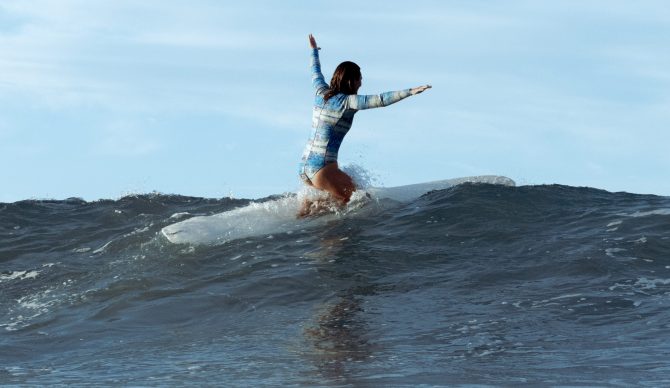
Beach breaks can be tough to read, but rewarding if you do the work. Photo: @ez.rivero
Editor’s Note: If you’re interested in learning to hang five, ten, or heels from one of the world’s most stylish longboarders in 35 video lessons, check out Kassia Meador’s Definitive Guide to Longboarding 2.0 here. The Inertia readers get a 10 percent discount with code WELCOME10.
Beach breaks are mercurial creatures. Peaks here. Peaks there. Making sure you’re in the spot is a moving target, and navigating beach breaks can be difficult for any level of surfer. Even a pro logger like Kassia Meador can attest.
“Beach breaks are synonymous for being like, ‘Man, I thought I saw some good ones out there and now I’m out and I can’t find them,’” she says in her new course, Kassia Meador’s Guide to Longboarding 2.0.
It’s here where knowledge of a spot and tricks for managing energy and effort come in handy. Here are a few longboarding tips Kassia encourages people to keep in mind (or just put into practice) when surfing beach breaks:
1. Orient yourself on the beach before you get in the water.
“Really important, more so than anything when surfing a beach break, is to orient yourself,” Meador says.
You can start this while you’re on the beach stretching and getting ready to get into the water.
“Notice your wave. Like, ‘I want to surf that wave right there. Or I want to surf that wave right there.’ Notice landmarks on the beach. Kind of move over right in front of where you want to be taking off.”
2. Stay within the confines of your markers and use them to set your lineup.
Whether your marker is a palm tree, a lifeguard tower, or a volleyball net, once you’ve chosen one on the shore it is even more helpful to find one in the ocean.
“You put yourself almost in this triangle,” Kassia explains. “You have your beach landmark, you have your other landmark — whether it’s the coastline curves out that way or something — you have that landmark.”
You can also use this time to get a sense of how the channel is pulling surfers out the back, spotting any currents and movement in and out of the lineup.
3. Trust the turtle roll.
In beach breaks, and especially with longer boards, the turtle roll is crucial. Push through a set wave, get back on your board, and paddle back out the channel. Repeat. Some paddle outs are easier than others, but if you treat it like a sprint, you’ll stay in the best possible position for a smooth trip.
Get out the back, catch your breath, and wait again for the right waves to come to you.
“It’s so important when paddling out to have your markers and know if you’re getting sucked into the impact zone again, or you’re staying in the channel and just keep an eye on that channel and always book it, especially if it’s bigger. I like to go as fast as I possibly can just to get out the back and then I can take a breather and find my lineup again.”
Keeping track of your markers, paying attention to how the channel moves, and being aware of the best peaks and open faces will make surfing a beach break infinitely easier.
Access Kassia Meador’s Definitive Guide To Longboarding 2.0 to learn more longboarding tips, and save 10 percent with code INERTIA10. Take the next (cross) step today.

